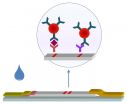(Press-News.org) Most recent advances in artificial intelligence -- such as mobile apps that convert speech to text -- are the result of machine learning, in which computers are turned loose on huge data sets to look for patterns.
To make machine-learning applications easier to build, computer scientists have begun developing so-called probabilistic programming languages, which let researchers mix and match machine-learning techniques that have worked well in other contexts. In 2013, the U.S. Defense Advanced Research Projects Agency, an incubator of cutting-edge technology, launched a four-year program to fund probabilistic-programming research.
At the Computer Vision and Pattern Recognition conference in June, MIT researchers will demonstrate that on some standard computer-vision tasks, short programs -- less than 50 lines long -- written in a probabilistic programming language are competitive with conventional systems with thousands of lines of code.
"This is the first time that we're introducing probabilistic programming in the vision area," says Tejas Kulkarni, an MIT graduate student in brain and cognitive sciences and first author on the new paper. "The whole hope is to write very flexible models, both generative and discriminative models, as short probabilistic code, and then not do anything else. General-purpose inference schemes solve the problems."
By the standards of conventional computer programs, those "models" can seem absurdly vague. One of the tasks that the researchers investigate, for instance, is constructing a 3-D model of a human face from 2-D images. Their program describes the principal features of the face as being two symmetrically distributed objects (eyes) with two more centrally positioned objects beneath them (the nose and mouth). It requires a little work to translate that description into the syntax of the probabilistic programming language, but at that point, the model is complete. Feed the program enough examples of 2-D images and their corresponding 3-D models, and it will figure out the rest for itself.
"When you think about probabilistic programs, you think very intuitively when you're modeling," Kulkarni says. "You don't think mathematically. It's a very different style of modeling."
Joining Kulkarni on the paper are his adviser, professor of brain and cognitive sciences Josh Tenenbaum; Vikash Mansinghka, a research scientist in MIT's Department of Brain and Cognitive Sciences; and Pushmeet Kohli of Microsoft Research Cambridge. For their experiments, they created a probabilistic programming language they call Picture, which is an extension of Julia, another language developed at MIT.
What's old is new
The new work, Kulkarni says, revives an idea known as inverse graphics, which dates from the infancy of artificial-intelligence research. Even though their computers were painfully slow by today's standards, the artificial intelligence pioneers saw that graphics programs would soon be able to synthesize realistic images by calculating the way in which light reflected off of virtual objects. This is, essentially, how Pixar makes movies.
Some researchers, like the MIT graduate student Larry Roberts, argued that deducing objects' three-dimensional shapes from visual information was simply the same problem in reverse. But a given color patch in a visual image can, in principle, be produced by light of any color, coming from any direction, reflecting off of a surface of the right color with the right orientation. Calculating the color value of the pixels in a single frame of "Toy Story" is a huge computation, but it's deterministic: All the variables are known. Inferring shape, on the other hand, is probabilistic: It means canvassing lots of rival possibilities and selecting the one that seems most likely.
That kind of inference is exactly what probabilistic programming languages are designed to do. Kulkarni and his colleagues considered four different problems in computer vision, each of which involves inferring the three-dimensional shape of an object from 2-D information. On some tasks, their simple programs actually outperformed prior systems. The error rate of the program that estimated human poses, for example, was between 50 and 80 percent lower than that of its predecessors.
Learning to learn
In a probabilistic programming language, the heavy lifting is done by the inference algorithm -- the algorithm that continuously readjusts probabilities on the basis of new pieces of training data. In that respect, Kulkarni and his colleagues had the advantage of decades of machine-learning research. Built into Picture are several different inference algorithms that have fared well on computer-vision tasks. Time permitting, it can try all of them out on any given problem, to see which works best.
Moreover, Kulkarni says, Picture is designed so that its inference algorithms can themselves benefit from machine learning, modifying themselves as they go to emphasize strategies that seem to lead to good results. "Using learning to improve inference will be task-specific, but probabilistic programming may alleviate re-writing code across different problems," he says. "The code can be generic if the learning machinery is powerful enough to learn different strategies for different tasks."
INFORMATION:
Related links
ARCHIVE:
Orienteering for robots
ARCHIVE:
Better robot vision
PROVIDENCE, R.I. [Brown University] -- Men who reported taking muscle-building supplements, such as pills and powders with creatine or androstenedione, reported a significantly higher likelihood of having developed testicular cancer than men who did not use such supplements, according to a new study in the British Journal of Cancer.
Moreover, said study senior author Tongzhang Zheng, the associated testicular germ cell cancer risk was especially high among men who started using supplements before age 25, those who used multiple supplements and those who used them for ...
Over the past several decades, the progress in micro fabrication technology has revolutionized the world in such fields as computing, signal processing, and automotive manufacturing.
Making various types of instruments smaller is another example of how the use of this technology has produced significant advancements. One such instrument is the gas chromatography system used in a number of scientific, medical, and industrial settings to separate and analyze dangerous, volatile organic compounds in gases, liquids, and solids.
For the past several years, Masoud Agah, an ...
Amsterdam, April 13, 2015 - The taste and color of your wine depends on the methods used to produce it and the chemicals added during production, says research published in Analytical Chemistry Research. The researchers behind the study say wine bottles should carry information about what the manufacturers add during processing - including sugars and acids.
In the study, Dr. Heli Sirén and her colleagues from the University of Helsinki, Finland, analyzed the chemical profiles of eight Pinot Noir wines from different regions - the USA, France, New Zealand and Chile. ...
VTT is the first in the world to have developed a drug test printed on paper. VTT used antibodies - produced by methods of molecular biology - as morphine sensing molecules when creating this printing technology-based morphine test. Using printing technology to manufacture rapid tests enables high production volumes and low production costs.
A paper-based test enables a rapid analysis of whether a compound - in this case, morphine - is present in a given sample. Possible future applications of the developed test include drug testing at workplaces and in connection with ...
PHILADELPHIA - Emergency department patients have misperceptions about opioid dependence and want more information about their pain management options, according to a new study from researchers at the Perelman School of Medicine at the University of Pennsylvania. The study, published online in the Annals of Emergency Medicine, found that patients seen in the emergency department for acute pain expressed a desire for better communication from physicians about their pain management options, along with discussion of the risks of opioid dependence.
The study used semi-structured ...
BELLINGHAM, Washington, USA - The latest issue of the journal Neurophotonics features a tribute to the brilliance and originality of Lawrence (Larry) Cohen as well as reports on the latest advances in voltage-sensitive dyes and multiple-site optical recording methods enabled by the work of Cohen and his team. Their research has paved the way for advances in functional imaging of the electrical activity of live tissue in real time, say journal editors.
Neurophotonics is published by SPIE, the international society for optics and photonics. All articles in the journal are ...
Low weight at birth increased the risk of disability pension among men, reveals a new Finnish study published in the PLoS One. Around 20% of the cohort members born in 1934-44 retired on a disability pension between 1971 and 2011.
Early exit from the workforce due to a disability pension might be related to non-optimal growth during the fetal period, says Docent Mikaela von Bonsdorff from the University of Jyväskylä.
The leading causes of disability pension are mental disorders, musculoskeletal disorders and cardiovascular diseases. Low birth weight was ...
Neuherberg, March 13, 2015. Elastases of white blood cells are involved in tissue destruction and can thus cause various diseases. Scientists from the Helmholtz Zentrum München have discovered a new isoform which could be involved both in the pathogenesis of diseases such as pulmonary emphysema as well as in the failure of some therapy approaches. The results of the study have just been published in the journal Nature Communications.
A delicate balance of elastases and elastase inhibitors provides for regular tissue formation and destruction in the body. A perturbation ...
COLUMBUS, Ohio -- Researchers studying the commonly used pain reliever acetaminophen found it has a previously unknown side effect: It blunts positive emotions.
In the study, participants who took acetaminophen reported less strong emotions when they saw both very pleasant and very disturbing photos, when compared to those who took placebos.
Acetaminophen, the main ingredient in the over-the-counter pain reliever Tylenol, has been in use for more than 70 years in the United States, but this is the first time that this side effect has been documented.
Previous research ...
Richard III may have kept his severe scoliosis hidden until death
Body of a king part of propaganda of power
'Crookback Richard' myth and the treatment of his corpse linked
Last month saw the mortal remains of King Richard III reinterred at Leicester Cathedral, more than two years after University of Leicester archaeologists discovered his skeleton in a car park in August 2012.
The body of a mediaeval monarch was always under scrutiny, and Richard III's was no exception. In death, however, his body became subject to new forms of examination and interpretation: stripped ...

